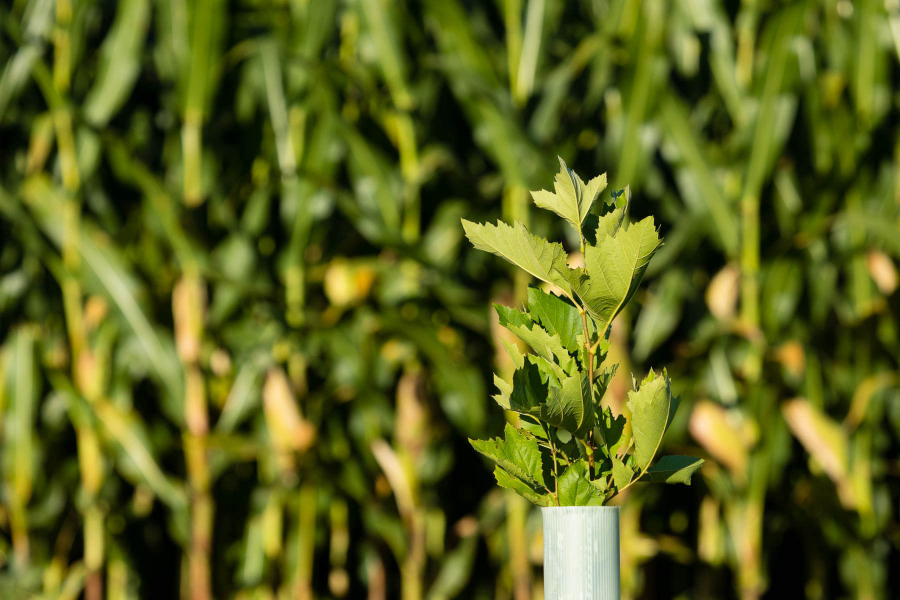The best ways to manage pollution

You depend on the water in your backyard for drinking, bathing and recreational activities. Actions that local governments, businesses and individuals in your community are taking to keep pollution—such as nutrients and sediment—from entering your local waterways are referred to as best management practices (BMPs) or conservation practices.
BMPs are practices that provide the most effective ways to reduce or prevent pollution from sources including roads, fields or even your roof from entering local waterways. This is called non-point source pollution because it doesn’t come from an identifiable, specific location such as a pipe coming out of a factory.
What are some examples of best management practices?
BMPs can be found in rural, urban and suburban environments, helping to combat pollution from stormwater to agricultural runoff. Let’s look at some examples.
Forest buffers
Trees, shrubs and grasses can be planted next to streams and rivers to help stabilize stream banks, prevent pollution from entering the water, provide food and habitat to wildlife, keep water cool during hot weather and can even be economically beneficial if used to grow fruits or vegetables.
Cover crops
After main crops like corn or soybeans are harvested, farmers can plant short-term crops on their fields. This not only helps to reduce nutrient and sediment pollution leaving the field, but it can also provide additional economic benefits to the farmer, improve soil health and reduce erosion.
Urban tree canopy
Planting trees in urban and suburban areas provide a range of benefits from reducing stormwater runoff and improving water quality, to mitigating the urban heat island effect, providing habitat for plants and animals and trapping air pollution.
Rain gardens
An area planted with grasses and flowering plants, rain gardens collect rain water as it runs off from a roof, driveway or street, allowing it to soak into the ground. This process helps to filter out pollution, provide food and shelter for insects, birds and other types of wildlife.
Permeable pavement
An alternative type of pavement that allows stormwater runoff to filter through the pavement surface to underlying layers, often made of soil and gravel. Permeable pavements filter out pollution, reduce the need for road salt in the wintertime and reduce construction costs for residential and commercial development by reducing the need for some conventional drainage features.
How are best management practices evaluated?
A BMP can’t just be anything you want it to be. They are unique, and it is important to understand the effect of BMPs in reducing pollution when they are implemented. For instance, some practices may be very beneficial for aesthetic purposes, but have little or no impact on reducing pollution to local waterways.
The Chesapeake Bay Program has a formal process for evaluating BMPs, including expert panels which determine if something is a BMP and if so, how much pollution it can be credited with reducing. Once a BMP is installed, it can be tracked and reported as helping to meet water quality goals.
The six watershed states – Delaware, Maryland, New York, Pennsylvania, Virginia and West Virginia – along with the District of Columbia, have verification processes to ensure that BMPs are implemented correctly and effectively reducing pollution.
Why verify your best management practices?
BMPs can help your local community and state in meeting their pollution reduction goals under the Chesapeake Bay Total Maximum Daily Load (Bay TMDL). The Bay TMDL, established by the U.S. Environmental Protection Agency in 2010, identifies the necessary nutrient and sediment pollution limits for each of the six watershed states and the District of Columbia to achieve a healthy Bay.
Each of these entities develop a Watershed Implementation Plan (WIP) to help determine how they can reduce pollution to meet their reduction goals.
BMPs are helpful and efficient pollution reduction activities that states can use to show they are doing their part to meet their Bay TMDL goals. Phase III of the WIPs, which will take the six watershed states and the District of Columbia to 2025, offers hundreds more BMPs available for credit than the previous plans.
Throughout 2016, the U.S. Environmental Protection Agency approved verification processes for each of the six watershed states and the District of Columbia.
Learn more about best management practices
The Chesapeake Bay Program recently released the Quick Reference Guide for Best Management Practices, a comprehensive guide that distills information about the Bay Program’s hundreds of approved BMPs into fact sheets for farmers, landowners, planners, resource managers and conservation districts.

Comments
this website is so helpful for school
like this website
Thank you!
Your comment has been received. Before it can be published, the comment will be reviewed by our team to ensure it adheres with our rules of engagement.
Back to recent stories